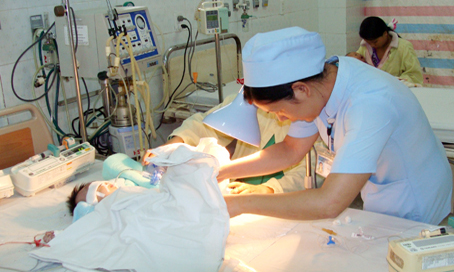In particular, Dr. Tran Ngoc Huu, Head of Pasteur Institute in HCMC said, HFMD in Dong Nai grew more quickly than other Southern provinces and cities.
* * Screening is intensive but not deep
According to Dr. Ngoc Huu, in 2010, Dong Nai had 412 cases and no death but as of August 2011, the province found 3,700 cases, almost 10 times higher than last year, and 15 reported deaths. Among them, males made up 57%; 98% of deaths were children under five. 75% out of 49 blood test samples were positive for EV71 virus. “Disease control would be better if Dong Nai could swiftly zone the “hot spots” with EV7-positive children under five, categorize to indentify which kindergarten, which group of family and which family they are from, and how the surrounding environments are, and even conduct epidemic investigation for links among the cases. The sector should make epidemic mapping, that the line graph goes up shows how ineffective the solutions are,” Dr. Huu said.
 |
| Caring for a child patient with HFMD in Dong Nai Children’s Hospital. Photo credit: U. Uyen
|
In reality, the disease is spreading so fast, the provincial regulative agencies become embarrassed at adopting their solutions. The most common and major solution is to sterilize kindergartens, groups of children in families, ect. with chloramines B on a large scale. Spraying for screening control is good strategy but not enough. Chloramines B is being provided to every home with under-five children is also right one but there’s no way of determining how it is used.
** So, what is the successful precautionary measure?
Since June, the Provincial People's Committee has had dozens of meetings held, dozens of documents regarding to prevention and control against disease released to relevant sectors but all failed to stop its rise. A sudden increase in June remains through July and August. As said by Minister of Health, Dong Nai, as well as other provinces and cities, was confused of defining whether HFMD was a disease or epidemic. Until the epidemic broke out, all solution seemed inefficient.
A lack of propaganda about the disease is one of the shortcomings. Mass communication should come before the precautionary measures.
Health sector is looking at why the epidemic suddenly ascends this year. It may be caused by every-two-to-four-year cycle or other roots. Therefore, communication, monitoring and spraying is needed to stop short the disease before the new school year starts.
L.H (Dong Nai Newspaper)